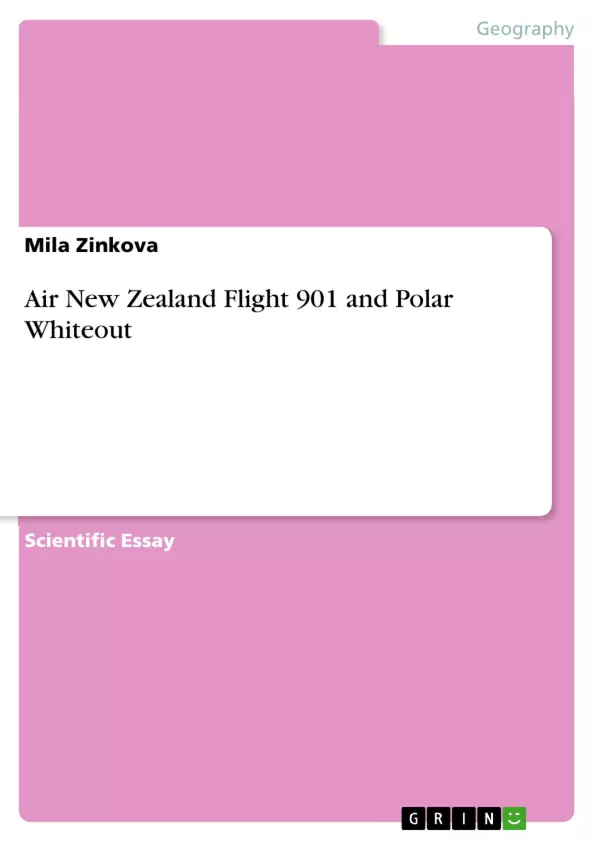On 28 November 1979 on a sightseeing flight to Antarctica, the Air New Zealand Flight 901 crashed on the slopes of Mount Erebus. All 237 passengers and 20 crewmembers perished on the impact. Two investigations that followed both agreed that due to the Polar Whiteout the crewmembers of Flight 901 had not seen the mountain. This article offers a discussion on whiteouts in general and in regards to the accident. It explores other phenomena that could have led to the tragedy, namely spatial disorientation illusions.
Table of Contents
- 1. Abstract
- 2.1 Introduction
- 2. Polar Whiteouts
Objectives and Key Themes
This article aims to analyze the circumstances surrounding the Air New Zealand Flight 901 crash on Mount Erebus in 1979. It examines the role of polar whiteouts in the accident and explores alternative or contributing factors.
- The Air New Zealand Flight 901 crash and its investigation.
- The phenomenon of polar whiteouts and its impact on visibility.
- Alternative explanations for the pilots' spatial disorientation.
- Eyewitness accounts and descriptions of polar whiteouts.
- Scientific explanations of light scattering and reflection in polar conditions.
Chapter Summaries
1. Abstract: This abstract summarizes the Air New Zealand Flight 901 crash, highlighting the loss of life and the subsequent investigations that attributed the crash to a polar whiteout. It briefly mentions the article's intent to discuss whiteouts and other potentially contributing factors, specifically spatial disorientation illusions. The abstract sets the stage for a deeper exploration of the incident and the meteorological phenomena involved.
2.1 Introduction: This introductory section details the sequence of events leading up to the Air New Zealand Flight 901 crash. It describes the flight plan, the communication with air traffic control, and the plane's descent towards Mount Erebus. The section contrasts the crew's perceived environment (flat sea ice) with the reality (a collision course with a mountain). It introduces the conflicting interpretations of the crash by the two main investigations, highlighting their differing understandings of the role of polar whiteouts. The introduction sets the stage for a detailed examination of the meteorological conditions and other potential factors contributing to the tragedy. It also foreshadows the article's intention to challenge the prevailing "sector whiteout" theory.
2. Polar Whiteouts: This chapter provides a comprehensive explanation of polar whiteouts, defining the phenomenon as a meteorological condition characterized by diffuse reflection and scattering of light. It draws upon various sources, including scientific literature and eyewitness accounts, to describe the visual effects of a whiteout, the lack of shadows and discernible horizon, and the difficulty of perceiving depth and distance. The chapter distinguishes true polar whiteouts from other visibility-reducing conditions such as fog or haze, emphasizing that they occur in clear air. The discussion also includes accounts from those who experienced polar whiteouts, describing the disorienting nature of the phenomenon and the challenges it presents to navigation. This section aims to present a scientifically grounded understanding of polar whiteouts while acknowledging the subjective experiences of those who have witnessed the phenomenon.
Keywords
Air New Zealand Flight 901, Mount Erebus, polar whiteout, spatial disorientation, aviation accident, visibility, meteorological conditions, Antarctic aviation, flight safety.
Air New Zealand Flight 901 Crash: Analysis of Polar Whiteouts and Contributing Factors - FAQ
What is the main topic of this document?
This document provides a comprehensive preview of an article analyzing the Air New Zealand Flight 901 crash on Mount Erebus in 1979. It focuses on the role of polar whiteouts in the accident and explores other potential contributing factors, such as spatial disorientation.
What are the key themes explored in the article?
The key themes include the investigation of the Air New Zealand Flight 901 crash, the phenomenon of polar whiteouts and their impact on visibility, alternative explanations for the pilots' spatial disorientation, eyewitness accounts of polar whiteouts, and scientific explanations of light scattering and reflection in polar conditions.
What is a polar whiteout?
A polar whiteout is a meteorological condition characterized by diffuse reflection and scattering of light, resulting in a lack of shadows, an indistinguishable horizon, and significant difficulty in perceiving depth and distance. It occurs in clear air, unlike fog or haze.
What is the significance of the Air New Zealand Flight 901 crash in this analysis?
The Air New Zealand Flight 901 crash serves as a case study to examine the impact of polar whiteouts on aviation safety. The analysis investigates whether the whiteout was the sole cause or if other factors contributed to the crash.
What are the chapter summaries included in this preview?
The preview includes summaries of the abstract, introduction, and a chapter specifically dedicated to polar whiteouts. The abstract summarizes the crash and the article's aims. The introduction details the events leading to the crash and the differing interpretations of the cause. The polar whiteouts chapter explains the phenomenon in detail, including scientific and eyewitness accounts.
What are the keywords associated with this article?
Keywords include Air New Zealand Flight 901, Mount Erebus, polar whiteout, spatial disorientation, aviation accident, visibility, meteorological conditions, Antarctic aviation, and flight safety.
What is the overall objective of this analysis?
The article aims to provide a thorough analysis of the circumstances surrounding the Air New Zealand Flight 901 crash, going beyond the initial conclusions to consider other possible contributing factors alongside the role of polar whiteouts. It seeks to present a scientifically accurate and nuanced understanding of the event.
What types of evidence are used in this analysis?
The analysis utilizes various sources of evidence, including scientific literature on polar meteorology, official investigation reports, and eyewitness accounts from individuals who experienced polar whiteouts.
Where can I find the full article?
The provided text is a preview only. The full article is not included here.
- Quote paper
- Mila Zinkova (Author), 2019, Air New Zealand Flight 901 and Polar Whiteout, Munich, GRIN Verlag, https://www.grin.com/document/459457



